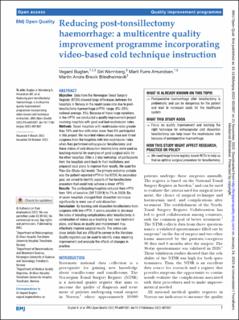| dc.contributor.author | Bugten, Vegard | |
| dc.contributor.author | Wennberg, Siri | |
| dc.contributor.author | Amundsen, Marit Furre | |
| dc.contributor.author | Blindheimsvik, Martin Andre Brevik | |
| dc.date.accessioned | 2023-01-26T14:40:10Z | |
| dc.date.available | 2023-01-26T14:40:10Z | |
| dc.date.created | 2022-12-01T14:17:23Z | |
| dc.date.issued | 2022 | |
| dc.identifier.citation | BMJ Open Quality. 2022, 11 (4), . | en_US |
| dc.identifier.issn | 2399-6641 | |
| dc.identifier.uri | https://hdl.handle.net/11250/3046657 | |
| dc.description.abstract | Objective Data from the Norwegian Tonsil Surgery Register (NTSR) showed large differences between the hospitals in Norway in the readmission rate due to post-tonsillectomy haemorrhage (rrPTH; range, 0%–25%; national average, 8%). Because of these large variations in the rrPTH, we conducted a quality improvement project involving hospitals with good and bad readmission rates.
Methods Seven hospitals with readmission rates greater than 10% and four with rates lower than 5% participated in this project. We recorded videos of ear, nose and throat surgeons from the hospitals with low readmission rates when they performed extracapsular tonsillectomy, and these videos of cold dissection tonsillectomy were used as teaching material for examples of good surgical skills for the other hospitals. After a 2-day workshop, all participants from the hospitals went back to their institutions and prepared local plans to improve their results. We used the Plan–Do–Study–Act model. The primary outcome variable was the patient-reported rrPTH in the NTSR. As secondary goal, we aimed to identify aspects of the tonsillectomy procedure that could help achieve a lower rrPTH.
Results The participating hospitals reduced their rrPTH from 18% at baseline (2017/2018) to 7% in 2020. Six of seven hospitals changed their dissection technique significantly to more use of cold dissection.
Conclusion By learning cold dissection tonsillectomy from surgeons with low rrPTH, it seems possible to decrease the rates of bleeding complications after tonsillectomy. A combination of videos as a teaching tool, new treatment plans, and focus on quality and improvement may effectively improve surgical results. The videos can show details that are difficult to convey in the literature. Quality registers can be used to identify areas requiring improvement and evaluate the effects of changes in practice. | en_US |
| dc.language.iso | eng | en_US |
| dc.publisher | BMJ Publishing Group Ltd | en_US |
| dc.rights | Navngivelse-Ikkekommersiell 4.0 Internasjonal | * |
| dc.rights.uri | http://creativecommons.org/licenses/by-nc/4.0/deed.no | * |
| dc.title | Reducing post-tonsillectomy haemorrhage: a multicentre quality improvement programme incorporating video-based cold technique instruction | en_US |
| dc.title.alternative | Reducing post-tonsillectomy haemorrhage: a multicentre quality improvement programme incorporating video-based cold technique instruction | en_US |
| dc.type | Peer reviewed | en_US |
| dc.type | Journal article | en_US |
| dc.description.version | publishedVersion | en_US |
| dc.source.pagenumber | 0 | en_US |
| dc.source.volume | 11 | en_US |
| dc.source.journal | BMJ Open Quality | en_US |
| dc.source.issue | 4 | en_US |
| dc.identifier.doi | 10.1136/bmjoq-2022-001887 | |
| dc.identifier.cristin | 2087171 | |
| cristin.ispublished | true | |
| cristin.fulltext | original | |
| cristin.qualitycode | 1 | |

